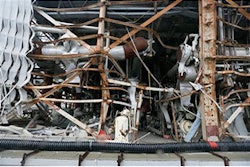WICHITA, Kan. (AP) — Unfazed by its counterparts pulling out of Kansas, SandRidge Energy plans to spend $350 million next year to punch an additional 100 horizontal wells and build associated infrastructure in the Mississippian Lime formation in the state, a top executive told The Associated Press.
"So just by that number alone you can gauge our interest in the Kansas area," said David Lawler, executive vice president and chief operating officer for the Oklahoma City-based firm.
His comments in a phone interview last week stand in sharp contrast to Shell Oil Co.'s September announcement that the oil giant would pull up stakes and sell its Kansas assets. The Shell move was the latest in a litany of major oil exploration companies that have given up on the Kansas side of the Mississippian Lime formation.
Using horizontal drilling and a technique known as hydraulic fracturing, or "fracking," to coax out oil and natural gas, companies have amassed fortunes from the porous limestone formation in northern Oklahoma and had hoped to do the same in southern and western Kansas. But as major oil players moved out, the focus in the past few months shifted to the stragglers, such as SandRidge, and the speculation regarding its plans for more than 1 million acres of mineral leases the firm had purchased.
SandRidge, which popularized horizontal drilling in the lime formation starting in 2010, has 170 producing wells in Kansas.
Lawler acknowledged his firm took "a pretty aggressive exploration program" when it drilled its first 25 exploration wells in Kansas with mixed results. Some showed really good results — as prolific as wells in Oklahoma — while some did poorly.
But after a shareholder revolt last spring, the company's new management has emphasized improving profitability and scaled back exploration.
"At this point we are taking a more measured approach and ensuring that we understand all aspects of the area that we are drilling in," he said. "So we are going a little slower than we have in the past because the rock does change from county to county in Kansas to a greater degree than in Oklahoma."
There are geological differences between the lime formation below Oklahoma and Kansas, experts say. Unlike Oklahoma, the formation on the Kansas side is typically shallower and varies in depth, making it more difficult to find the "sweet spot" where oil can be profitably extracted.
SandRidge has had "strong" successes with wells in Barber and Harper counties in south-central Kansas as well as Finney and Hodgeman counties in southwest Kansas, Lawler said. It plans to let some leases go and add leases in more promising areas. The company expects to operate six rigs in Kansas next year.
In its securities filing earlier this month, SandRidge reported $252 million in adjusted EBITDA — earnings before interest, taxes, depreciation, and amortization — for the third quarter of 2013. The net loss to common stockholders was $87 million.
Mississippian production accounted for 53 percent of the company's total production in the third quarter, according to the report.
Kansas Independent Oil and Gas Association has always been "cautiously optimistic" about the Mississippian Lime development, but group president Ed Cross notes horizontal drilling production was just 7.7 percent of the state's total oil production last year and 6 percent the previous year.
Between January 2010 to September 2013, Kansas issued 21,353 drilling permits in the state — with just 515 of them for Mississippian Lime horizontal wells, he said.
"It is easy to get excited about an unconventional play that is coming to your state," Cross said. "But it was an emerging play in Kansas, it wasn't a proven one yet — a lot of leasing activity and high hopes."
Shell halted its Kansas exploratory drilling program in May and has put its 625,000 acres of mineral leases in Kansas up for sale, the company said.
"While Kansas has potential, other opportunities within the Shell portfolio provided more growth opportunities," Shell spokeswoman Kimberly Windon wrote in an email.
SandRidge contends that with its lower overhead, it can more efficiently develop its assets in the formation than oil giants like Shell.
"We have been doing very well in that same area and we have the same type of data that Shell has," Lawler said. "We see opportunity across all of Kansas."






















